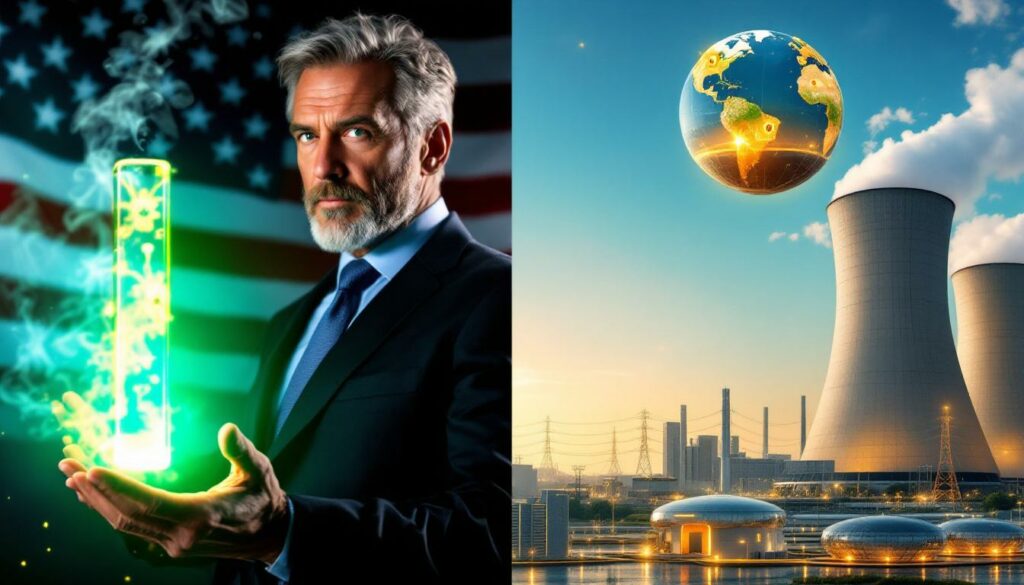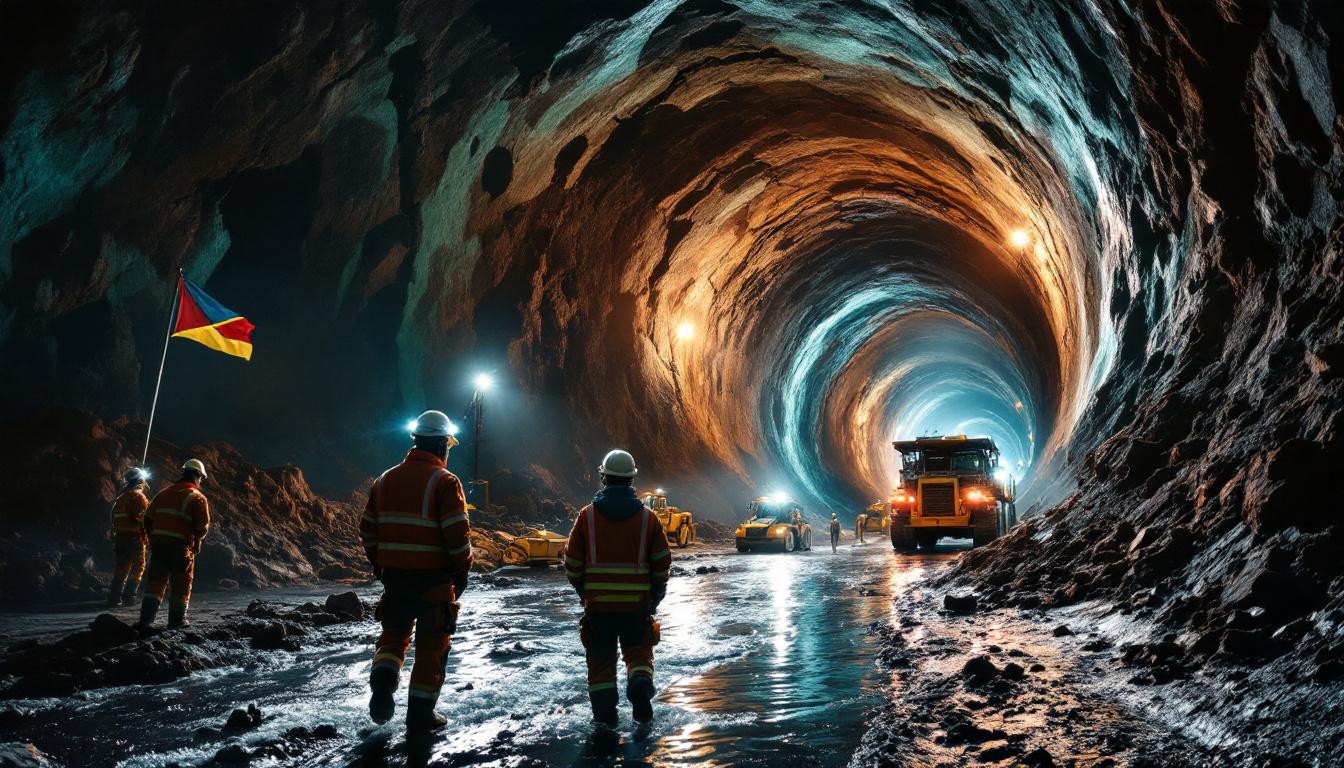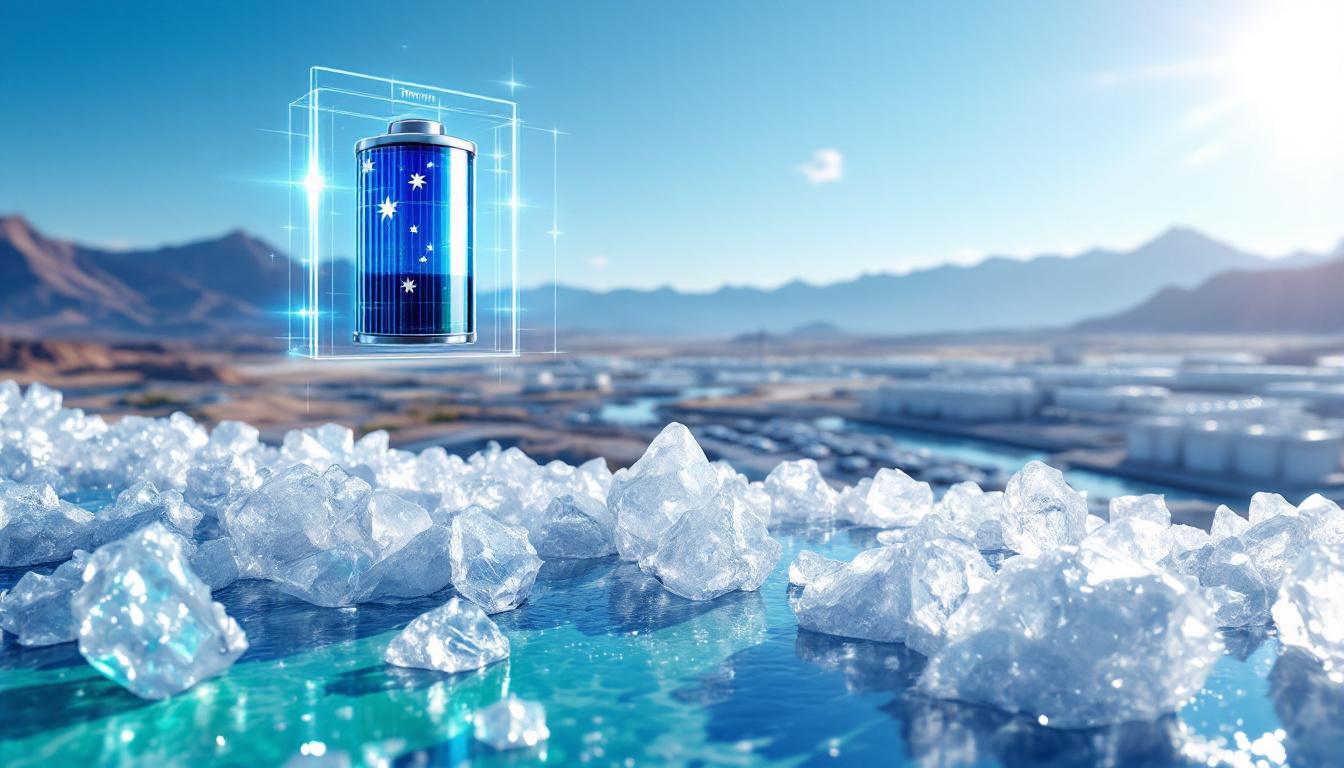The Nuclear Renaissance Under Trump's Administration
The global uranium industry is experiencing a seismic shift following Donald Trump's recent executive orders aimed at revitalizing America's nuclear energy sector. These orders outline an ambitious plan to quadruple US nuclear power generation from the current 100GW to a substantial 400GW by 2050—a goal that represents one of the most significant nuclear expansions in American history.
The executive orders specifically invoke the Defense Production Act, designating uranium as a critical mineral essential to national security. This designation enables the government to bypass certain regulatory hurdles and accelerate nuclear development through targeted funding and streamlined approvals.
"This marks a fundamental shift in US energy policy that positions nuclear power at the center of America's energy future," notes industry analyst Dr. Richard Harrington. "The implications for the global uranium supply chain are profound and far-reaching."
A cornerstone of the initiative includes plans to break ground on at least 10 new large-scale reactors by 2030, complemented by expedited approvals for Small Modular Reactors (SMRs) and advanced nuclear technologies. This aggressive timeline represents a dramatic departure from the decades-long stagnation in US nuclear construction.
Strategic Energy Independence Goals
The executive orders are explicitly designed to reduce America's dependence on foreign uranium suppliers, particularly those from Russia and China. Currently, the US relies on imports for approximately 95% of its uranium needs, creating significant vulnerabilities in its energy security infrastructure.
By establishing a robust domestic uranium supply chain, the administration aims to insulate the US from geopolitical pressures and potential supply disruptions. This involves not only mining but also developing enrichment capabilities that have largely moved offshore in recent decades.
The plan includes provisions for:
- Streamlining permitting processes for uranium mining on federal lands
- Providing tax incentives for domestic uranium production
- Establishing a strategic uranium reserve similar to the petroleum reserve
- Investing in advanced enrichment technologies to reduce dependence on foreign facilities
National Security Implications
The national security dimension of these executive orders cannot be overstated. By invoking the Defense Production Act, the administration has effectively placed uranium production in the same category as other defense-critical materials.
"Uranium isn't just about keeping the lights on—it's about maintaining technological superiority and energy security in an increasingly contested global environment," explains former Department of Energy official Sarah Langford.
This security focus extends beyond civilian applications to encompass military requirements for naval propulsion systems and defense infrastructure. The US Navy, which operates the largest fleet of nuclear-powered vessels globally, requires a steady supply of highly enriched uranium for its submarines and aircraft carriers.
Construction Timeline Targets
The executive orders establish aggressive construction timelines, aiming to initiate at least 10 new large reactors by 2030. This represents a dramatic acceleration compared to recent decades, during which only two new reactors have been completed in the United States (Vogtle Units 3 and 4 in Georgia).
To achieve these ambitious targets, the orders direct federal agencies to:
- Establish a streamlined regulatory pathway for standardized reactor designs
- Coordinate with state governments to address local permitting obstacles
- Provide federal loan guarantees to mitigate financial risks
- Create specialized workforce development programs to address skilled labor shortages
Industry experts estimate these initiatives could generate over 300,000 high-paying jobs in construction, engineering, and operations across the nuclear supply chain.
What's Driving the Renewed Focus on Nuclear Energy?
The AI Energy Crisis
A critical driver behind Trump's executive orders and uranium industry revival is the exploding energy demand from artificial intelligence and data centers. According to Goldman Sachs Research, tech giants alone will require between 85-90GW of additional power capacity by 2030 just to run their AI operations—equivalent to nearly the entire current US nuclear fleet.
"The power requirements for training large language models and running inference at scale are astronomical," notes Dr. Elena Ramirez, energy systems researcher. "A single AI training run can consume as much electricity as 100 American households use in a year."
This massive energy demand has already prompted tech companies to secure dedicated nuclear power sources:
- Microsoft signed a groundbreaking 20-year deal to reopen the decommissioned Three Mile Island nuclear plant
- Google placed orders for 6-7 small reactors from nuclear startup Kairos Power
- Amazon purchased a nuclear-powered data center adjacent to the Susquehanna nuclear plant from Talen Energy
- Oracle and Meta are reportedly in negotiations for similar long-term nuclear power purchase agreements
These corporate nuclear deals represent a fundamental shift in how energy is procured for data centers, moving from grid-based purchasing to direct investment in generation assets.
Low-Carbon Energy Requirements
The tech industry's interest in nuclear power extends beyond simple capacity concerns. Many technology companies have made ambitious commitments to carbon neutrality or net-zero operations, making the carbon intensity of their energy supply a critical consideration.
Nuclear power provides these companies with a reliable, 24/7 source of carbon-free electricity that can meet their sustainability goals while providing the consistent power needed for data center operations. Unlike intermittent renewable sources, nuclear plants operate at capacity factors exceeding 90%, providing the baseload reliability essential for computing infrastructure.
According to the International Energy Agency, nuclear power generates approximately 25% of the world's low-carbon electricity while producing lifecycle emissions comparable to wind power—between 5-10 grams of CO₂ equivalent per kilowatt-hour.
Geopolitical Energy Security Concerns
The Trump critical minerals order explicitly addresses the geopolitical vulnerabilities in the current uranium supply chain. Russia and China currently control approximately 57% of global enriched uranium production, with Russia's state-owned Rosatom being the world's largest uranium enrichment company.
"The concentration of enrichment capacity in Russia represents a strategic vulnerability that has become increasingly untenable in the current geopolitical environment," explains international security analyst Jonathan Reynolds.
This vulnerability extends to mining as well. Kazakhstan, which maintains close ties to both Russia and China, produces approximately 43% of the world's uranium. The combination of Russian enrichment dominance and Kazakh mining control creates a precarious supply situation for Western nuclear operators.
"We're currently in a situation where the West's clean energy future is dependent on uranium supply chains controlled by geopolitical competitors. That's an unsustainable position." — Dr. Mark Henderson, Energy Security Institute
The executive orders aim to counteract this dependency by incentivizing uranium production in allied nations, particularly Australia, Canada, and domestic US sources.
How Will the Global Uranium Market Transform?
Projected Demand Growth
The global uranium market is poised for significant transformation as demand projections rise dramatically. According to the World Nuclear Association's 2023 Nuclear Fuel Report, uranium demand is expected to increase by 28% from 2023 to 2030, growing from approximately 80,000 tonnes to 102,000 tonnes annually.
Looking further ahead, the outlook becomes even more bullish, with projections showing a 51% increase from 2031-2040, pushing annual requirements to around 120,000 tonnes. This growth trajectory is unprecedented in recent decades and represents a fundamental shift in uranium market volatility.
Several factors are driving this demand surge:
- New reactor construction in China, India, and potentially the US
- Life extensions for existing nuclear fleets
- Increased capacity factors at operating plants
- Growing interest in small modular reactors
- Tech sector power purchase agreements
"We're witnessing the beginning of what could be a multi-decade bull market for uranium," states commodity strategist Michael Chen. "The supply-demand imbalance has been building for years, but these executive orders could accelerate the timeline dramatically."
Supply Gap Concerns
Current global uranium production falls significantly short of projected demand, creating concerns about a widening supply gap. In 2023, worldwide uranium production totaled approximately 58,000 tonnes—well below the current demand of 80,000 tonnes. The shortfall has been met by drawing down secondary supplies, including government inventories and recycled material.
This supply-demand imbalance is exacerbated by the long lead times required to bring new uranium mines into production. Developing a conventional uranium mine typically takes 7-10 years from discovery to first production, creating potential bottlenecks as demand accelerates.
The Paladin Energy uranium halt in Namibia further illustrates the challenges facing uranium supply. The supply situation is further complicated by concentration risk:
| Country | % of Global Uranium Production (2023) |
|---|---|
| Kazakhstan | 43% |
| Canada | 15% |
| Australia | 9% |
| Namibia | 8% |
| Uzbekistan | 7% |
| Russia | 6% |
| Others | 12% |
"The market is recognizing that there simply isn't enough uranium production in the pipeline to meet future demand," explains resource analyst Rebecca Thomas. "This structural deficit creates significant upside potential for uranium prices and producers."
Uranium Enrichment Bottlenecks
Beyond mining, uranium enrichment represents another critical bottleneck in the nuclear fuel supply chain. Enrichment capacity is even more concentrated than mining, with just four companies dominating the global market:
- Rosatom (Russia) – 43% of global capacity
- CNNC (China) – 14% of global capacity
- Urenco (UK/Netherlands/Germany) – 29% of global capacity
- Orano (France) – 10% of global capacity
This concentration presents significant challenges for Western countries seeking to reduce reliance on Russian enrichment services. The US uranium tariff impact could further reshape market dynamics. The US domestic enrichment capacity, once the world's largest, has declined dramatically since the 1980s, with only one commercial enrichment facility currently operating in New Mexico.
Trump's executive orders specifically address this bottleneck by directing the Department of Energy to support the development of new enrichment facilities using advanced centrifuge technology. The orders also revise longstanding policies to allow the use of reprocessed fuel in commercial reactors, potentially reducing demand for newly mined uranium.
"Enrichment represents the most significant technical and financial barrier to establishing a secure nuclear fuel supply chain. Rebuilding this capability is essential to energy independence." — Former Nuclear Regulatory Commissioner William Barnes
What Opportunities Exist for Australia's Uranium Industry?
Australia's Uranium Resource Advantage
Australia occupies a unique position in the global uranium landscape, holding approximately one-third of the world's known recoverable uranium resources—the largest share of any country. Despite this resource dominance, Australia currently produces only about 9% of global uranium output, representing a significant untapped potential.
The country's uranium resources are distributed across several major deposits:
- Olympic Dam (South Australia) – The world's largest uranium deposit, containing an estimated 2.1 million tonnes of uranium
- Ranger (Northern Territory) – Historic producer now in rehabilitation
- Four Mile (South Australia) – Currently operating ISL mine
- Honeymoon (South Australia) – Under redevelopment
- Yeelirrie (Western Australia) – Undeveloped deposit under mining ban
- Mulga Rock (Western Australia) – Undeveloped deposit under mining ban
"Australia's uranium endowment is truly world-class, both in terms of quantity and quality," notes geologist Dr. Andrew Phillips. "Many deposits feature grades significantly above the global average, allowing for potentially lower production costs."
Regulatory and Policy Considerations
Despite its resource advantage, Australia's uranium industry has been constrained by state-based mining restrictions and complex regulatory frameworks. Western Australia, Queensland, and Victoria have historically maintained bans or moratoriums on uranium mining, effectively sterilizing significant portions of the country's resource base.
Recent political shifts, however, suggest a potential opening for policy reconsideration. The growing recognition of nuclear power's role in climate change mitigation, combined with increasing geopolitical pressures, has prompted renewed debate about Australia's uranium policies.
The federal export framework for uranium is well-established, with Australia maintaining bilateral nuclear cooperation agreements with 43 countries. These agreements include strict safeguards to ensure Australian uranium is used only for peaceful purposes, providing confidence to potential customers.
Trump's executive orders specifically highlight the importance of securing uranium supplies from allied nations, creating a potential opening for Australia to position itself as a preferred supplier to the US market. This strategic alignment could provide the political impetus needed to revisit state-based mining restrictions.
ASX Uranium Companies Positioned for Growth
The ASX hosts numerous uranium companies that have seen significant share price appreciation following Trump's executive orders. Notable performers include:
- Boss Energy (+24%) – Advancing the Honeymoon restart project in South Australia
- Deep Yellow (+16.7%) – Developing the Tumas project in Namibia with Australian management
- Terra Uranium (+16.67%) – Exploring uranium assets in Canada's Athabasca Basin
- Recharge Metals (+80%) – Pursuing uranium opportunities in the United States
Felicity Repacholi, Managing Director of Recharge Metals, highlighted the strategic opportunity: "The US needs uranium, and Recharge aims to be part of that solution. The focus is returning to the mine gate as security of supply becomes paramount."
These companies represent different approaches to capturing the uranium investment trends:
- Near-term producers like Boss Energy are focused on bringing idled mines back into production to capitalize on higher uranium prices
- Development-stage companies such as Deep Yellow are advancing projects toward production decisions
- Explorers including Terra Uranium are seeking to define new resources in established uranium districts
- Strategic acquirers like Recharge Metals are pursuing assets in key jurisdictions with favorable regulatory environments
"Australian uranium companies bring together world-class technical expertise and access to capital markets with a strong understanding of responsible uranium development," explains mining analyst James Foster. "This positions them well to play a significant role in meeting future uranium demand."
How Does Nuclear Power Support Global Climate Goals?
Nuclear's Role in Decarbonization
Nuclear power currently provides approximately 25% of the world's low-carbon electricity, making it a cornerstone of existing decarbonization efforts. In countries with substantial nuclear fleets like France (70% of electricity), Sweden (40%), and Switzerland (33%), emissions from the power sector are significantly lower than global averages.
From a lifecycle perspective, nuclear power generates minimal greenhouse gas emissions. According to the Intergovernmental Panel on Climate Change, nuclear energy's lifecycle emissions range from 5-10 grams of CO₂ equivalent per kilowatt-hour—comparable to wind power and significantly lower than solar PV (20-50g CO₂/kWh) and natural gas (400-500g CO₂/kWh).
The carbon intensity comparison becomes even more favorable when considering the full system costs of different generation types:
| Energy Source | Lifecycle Emissions (g CO₂/kWh) | Capacity Factor (%) | Land Use (km²/TWh) |
|---|---|---|---|
| Nuclear | 5-10 | 90-95% | 1-2 |
| Wind | 8-12 | 30-40% | 30-50 |
| Solar PV | 20-50 | 15-25% | 40-70 |
| Natural Gas | 400-500 | 50-60% | 2-5 |
| Coal | 800-1000 | 60-70% | 8-10 |
"Nuclear power's combination of low emissions, high reliability, and small land footprint makes it uniquely positioned to support deep decarbonization," explains climate scientist Dr. Rachel Nelson. "Its ability to provide firm, dispatchable power complements the intermittency of renewable sources."
Baseload Power Capabilities
One of nuclear power's most significant advantages in climate change mitigation is its ability to provide reliable baseload power. Unlike intermittent renewable sources that depend on weather conditions, nuclear plants typically operate at capacity factors exceeding 90%, providing consistent electricity regardless of external conditions.
This reliability becomes increasingly important as power grids face growing stresses from extreme weather events and fluctuating demand patterns. Nuclear plants have demonstrated remarkable resilience during extreme conditions, including during the 2019 polar vortex when nuclear facilities operated at near 100% capacity while other generation sources struggled.
"The climate crisis requires an all-hands-on-deck approach. Nuclear provides the clean, reliable backbone that allows for greater integration of variable renewable sources." — Dr. Kenneth Williams, Climate Solutions Institute
The baseload capabilities of nuclear power also reduce the need for backup generation capacity, typically provided by natural gas plants, which can significantly offset the emissions benefits of renewable deployment.
Small Modular Reactor Developments
The nuclear industry is undergoing a technological renaissance with the development of Small Modular Reactors (SMRs). These advanced designs, typically generating 50-300 megawatts of electricity compared to 1,000+ megawatts for conventional reactors, offer several advantages:
- Factory fabrication – Components built in controlled factory settings rather than on-site
- Scalable deployment – Ability to add capacity incrementally as needed
- Enhanced safety – Passive safety systems that don't require operator intervention
- Flexible siting – Can be located closer to population centers or industrial facilities
- Reduced construction timeframes – Potential for 3-5
Ready to Catch the Next Major Mineral Discovery?
Stay ahead of the market with Discovery Alert's proprietary Discovery IQ model, which instantly analyses ASX announcements to identify significant mineral discoveries before they make headlines. Explore how historic discoveries have delivered exceptional returns by visiting our dedicated discoveries page and start your 30-day free trial today.




